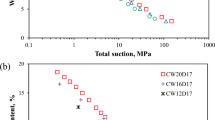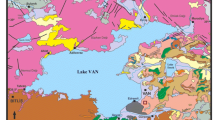Abstract
The effects of temperature on the behaviour of soils are of great concern in many geotechnical applications. This paper reports an experimental study that focused on the effect of temperature (between 20 and 50 °C) on the structural strength of a clayey soil using a modified micropenetrometer. Laboratory penetration tests using two penetration rates were conducted on highly overconsolidated specimens for which the degree of saturation (S r) and dry density (ρ d) were controlled. The results indicated that the penetration resistance (the total resistance, the friction and the end resistance) decreased with increasing temperature, suggesting that the structural strength of soil was softened by increasing the temperature. In addition, the rate of decrease in structural strength with increasing temperature was greater when the degrees of saturation was low and the dry density was high. Tests performed under cyclic heating and cooling revealed that subjecting the soil to this thermal cycling improves its structural strength. Moreover, increasing the rate of penetration caused higher penetration resistance, while its influence on the thermomechanical behaviour of the soil was only very slight.
















Similar content being viewed by others
References
Abuel-Naga HM, Bergado DT, Bouazza A (2007) Thermally induced volume change and excess pore water pressure of soft Bangkok clay. Eng Geol 89:144–154. doi:10.1016/j.enggeo.2006.10.002
Baldi G, Hueckel T, Pellegrini R (1988) Thermal volume changes of the mineral–water system in low-porosity clay soils. Can Geotech J 25:807–825
Becher H (1998) Resistances to penetration of aggregates from loess-derived topsoils at different soil water tensions. Soil Tillage Res 47:73–81. doi:10.1016/S0167-1987(98)00075-0
Bolzon G, Schrefler BA (2005) Thermal effects in partially saturated soils: a constitutive model. Int J Numer Anal Methods Geomech 29:861–877. doi:10.1002/nag.437
Campanella R, Mitchell J (1968) Influence of temperature variations on soil behavior. J Soil Mech Found 94:709–734
Cekerevac C, Laloui L (2004) Experimental study of thermal effects on the mechanical behaviour of a clay. Int J Numer Anal Methods Geomech 28:209–228. doi:10.1002/nag.332
Cui YJ, Sultan N, Delage P (2000) A thermomechanical model for saturated clays. Can Geotech J 37:607–620. doi:10.1139/t99-111
Delage P, Graham J (1996) Mechanical behaviour of unsaturated soils: understanding the behaviour of unsaturated soils requires reliable conceptual models. In: Proceedings of the 1st international conference on unsaturated soils, Paris, France, September 1995, vol 3. Balkema, A.A., Rotterdam, pp 1223–1256
Elbanna E, Witney B (1987) Cone penetration resistance equation as a function of the clay ratio, soil moisture content and specific weight. J Terramech 24:41–56
Farrell D, Greacen E (1966) Resistance to penetration of fine probes in compressible soil. Aust J Soil Res 4:1–17
Gardner R (1955) Relations of temperature to moisture tension of soil. Soil Sci 79:257–266
Grant S, Salehzadeh A (1996) Calculation of temperature effects on wetting coefficients of porous solids and their capillary pressure functions. Water Resour Res 32:261–270
Haghighi A, Medero G, Woodward P, Laloui L (2011) Effect of temperature on collapse potential of kaolin clay. In: Proc 5th Int Conf on Unsaturated Soils, Barcelona, Spain, 6–8 September 2010, pp 543–548
Hueckel T, Borsetto M (1990) Thermoplasticity of saturated soils and shales: constitutive equations. J Geotech Eng 116:1765–1777
Lingnau BE, Graham J, Yarechewski D et al (1996) Effects of temperature on strength and compressibility of sand-bentonite buffer. Eng Geol 41:103–115. doi:10.1016/0013-7952(95)00028-3
Liu Z, Shi B, Sheng D (2006) A micropenetrometer for detecting structural strength inside soft soils. Geotech Test J 29:1–8
Lloret A, Villar MV (2007) Advances on the knowledge of the thermo-hydro-mechanical behaviour of heavily compacted “FEBEX” bentonite. Phys Chem Earth Parts A/B/C 32:701–715. doi:10.1016/j.pce.2006.03.002
Low HE, Lunne T, Andersen KH et al (2010) Estimation of intact and remoulded undrained shear strengths from penetration tests in soft clays. Géotechnique 60:843–859. doi:10.1680/geot.9.P.017
Lunne T, Eide O, Ruiter J (1976) Correlations between cone resistance and vane shear strength in some Scandinavian soft to medium stiff clays. Can Geotech J 13:430–441
Mitchell J, Soga K (2005) Fundamentals of soil behavior, 3rd edn. Wiley, Hoboken, pp 109–141
Romero E, Gens A, Lloret A (1999) Water permeability, water retention and microstructure of unsaturated compacted Boom clay. Eng Geol 54:117–127. doi:10.1016/S0013-7952(99)00067-8
Romero E, Gens A, Lloret A (2001) Temperature effects on the hydraulic behaviour of an unsaturated clay. Geotech Geol Eng 19:311–332
Romero E, Gens A, Lloret A (2003) Suction effects on a compacted clay under non-isothermal conditions. Géotechnique 53:65–81. doi:10.1680/geot.2003.53.1.65
Romero E, Villar MV, Lloret A (2005) Thermo-hydro-mechanical behaviour of two heavily overconsolidated clays. Eng Geol 81:255–268. doi:10.1016/j.enggeo.2005.06.011
Saix C, Devillers P, El Youssoufi MS (2000) Éléments de couplage thermomécanique dans la consolidation de sols non saturés. Can Geotech J 37:308–317
Seneviratne H, Carter J (1993) A review of models for predicting the thermomechanical behaviour of soft clays. Int J Numer Anal Methods Geomech 17:715–733
Shi B, Liu Z, Cai Y (2005) Development of the super mini-penetrometer and its application. Rock Soil Mech 26:1211–1215
Shin YJ, Kim D (2011) Assessment of undrained shear strength based on Cone Penetration Test (CPT) for clayey soils. KSCE J Civ Eng 15:1161–1166. doi:10.1007/s12205-011-0808-6
Sultan N, Delage P, Cui Y (2002) Temperature effects on the volume change behaviour of Boom clay. Eng Geol 64:135–145. doi:10.1016/S0013-7952(01)00143-0
Tang A-M, Cui Y-J, Barnel N (2008) Thermo-mechanical behaviour of a compacted swelling clay. Géotechnique 58:45–54. doi:10.1680/geot.2008.58.1.45
Tang C-S, Shi B, Zhao L-Z (2010) Interfacial shear strength of fiber reinforced soil. Geotext Geomembr 28:54–62. doi:10.1016/j.geotexmem.2009.10.001
Towhata I, Kuntiwattanaku P, Seko I, Ohishi K (1993) Volume change of clays induced by heating as observed in consolidation tests. Soils Found 33:170–183
Uchaipichat A, Khalili N (2009) Experimental investigation of thermo-hydro-mechanical behaviour of an unsaturated silt. Geotechnique 59:339–353
Villar M, Lloret A (2004) Influence of temperature on the hydro-mechanical behaviour of a compacted bentonite. Appl Clay Sci 26:337–350. doi:10.1016/j.clay.2003.12.026
Wiebe B, Graham J, Tang GX, Dixon D (1998) Influence of pressure, saturation, and temperature on the behaviour of unsaturated sand-bentonite. Can Geotech J 35:194–205. doi:10.1139/t97-093
Acknowledgments
The authors wish to acknowledge the financial support provided by the Key Project of the Natural Science Foundation of China (nos. 40730739, 41230636), the Scientific Research Foundation of the Graduate School of Nanjing University (no. 2012CL11), the National Basic Research Program of China (no. 2011CB710605) and the National Natural Science Foundation of China (nos. 41072211, 41072210, 41322019).
Author information
Authors and Affiliations
Corresponding author
Rights and permissions
About this article
Cite this article
Gu, K., Tang, C., Shi, B. et al. A study of the effect of temperature on the structural strength of a clayey soil using a micropenetrometer. Bull Eng Geol Environ 73, 747–758 (2014). https://doi.org/10.1007/s10064-013-0543-y
Received:
Accepted:
Published:
Issue Date:
DOI: https://doi.org/10.1007/s10064-013-0543-y




